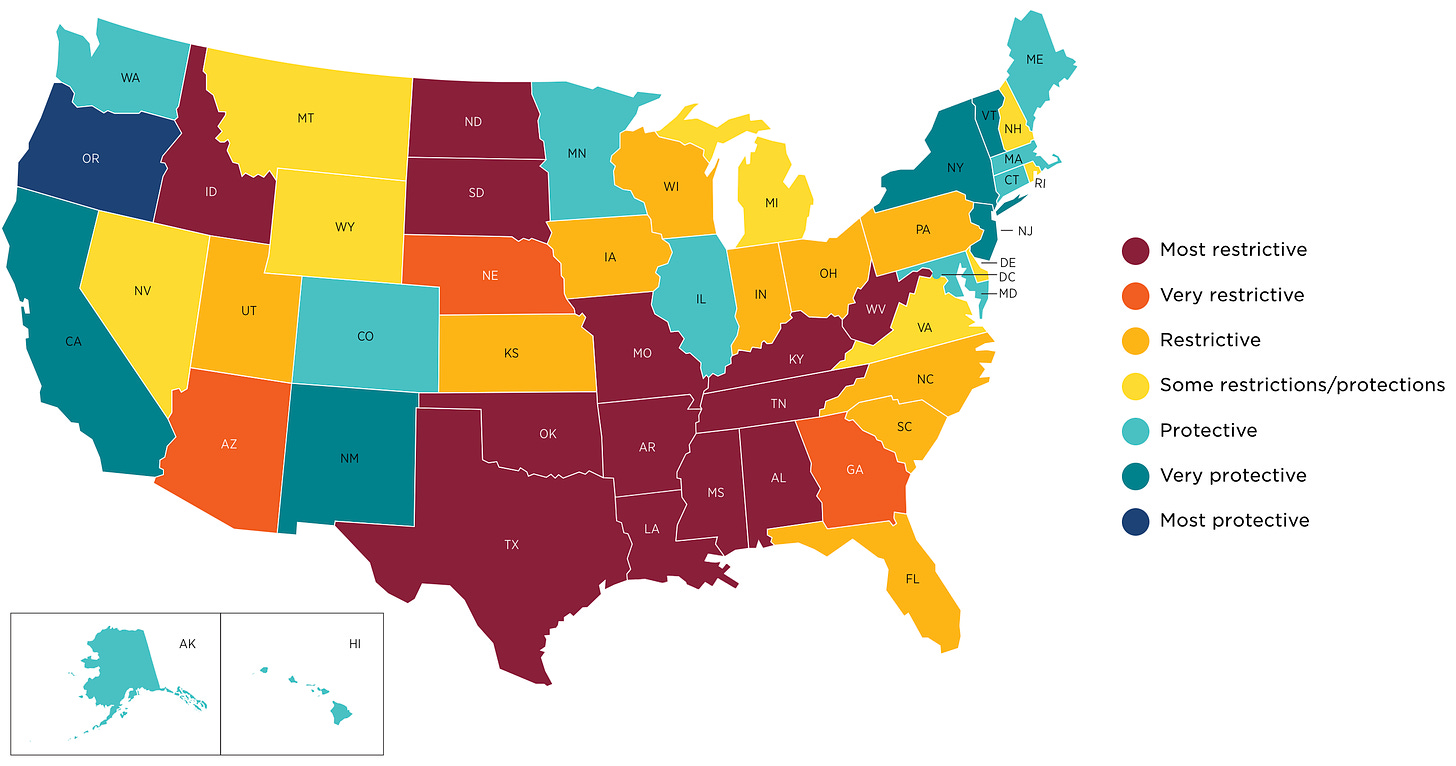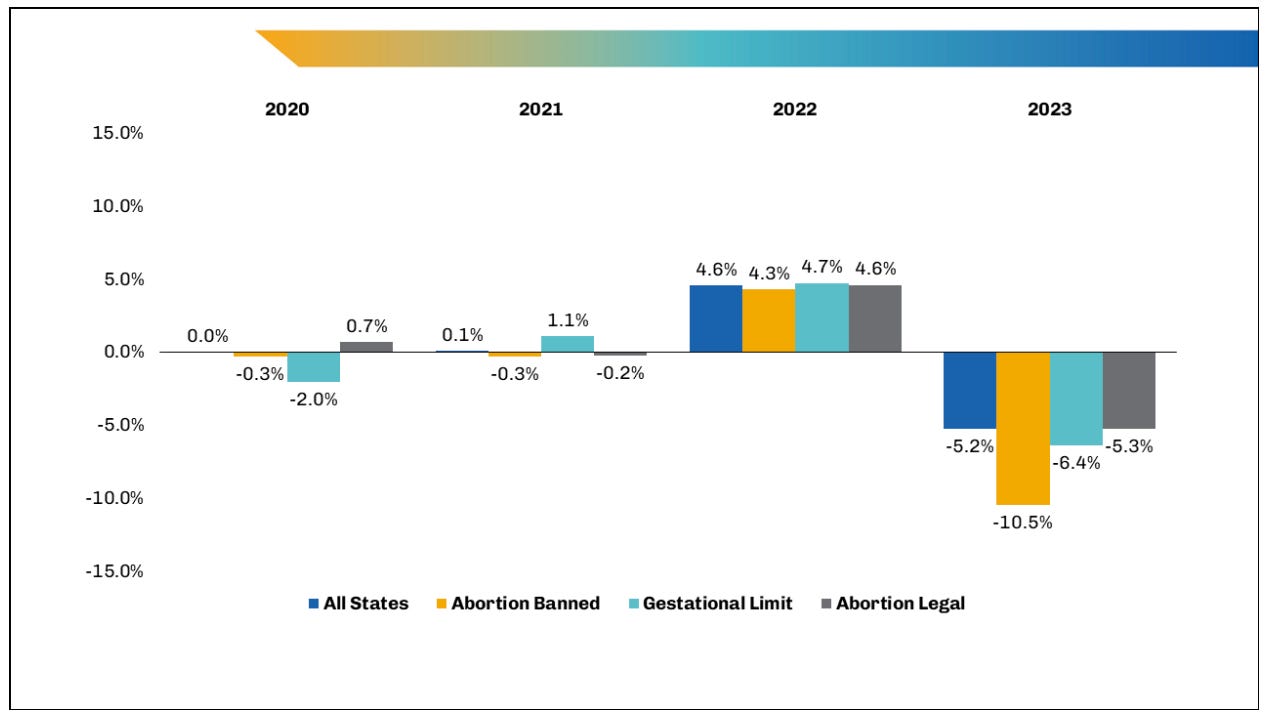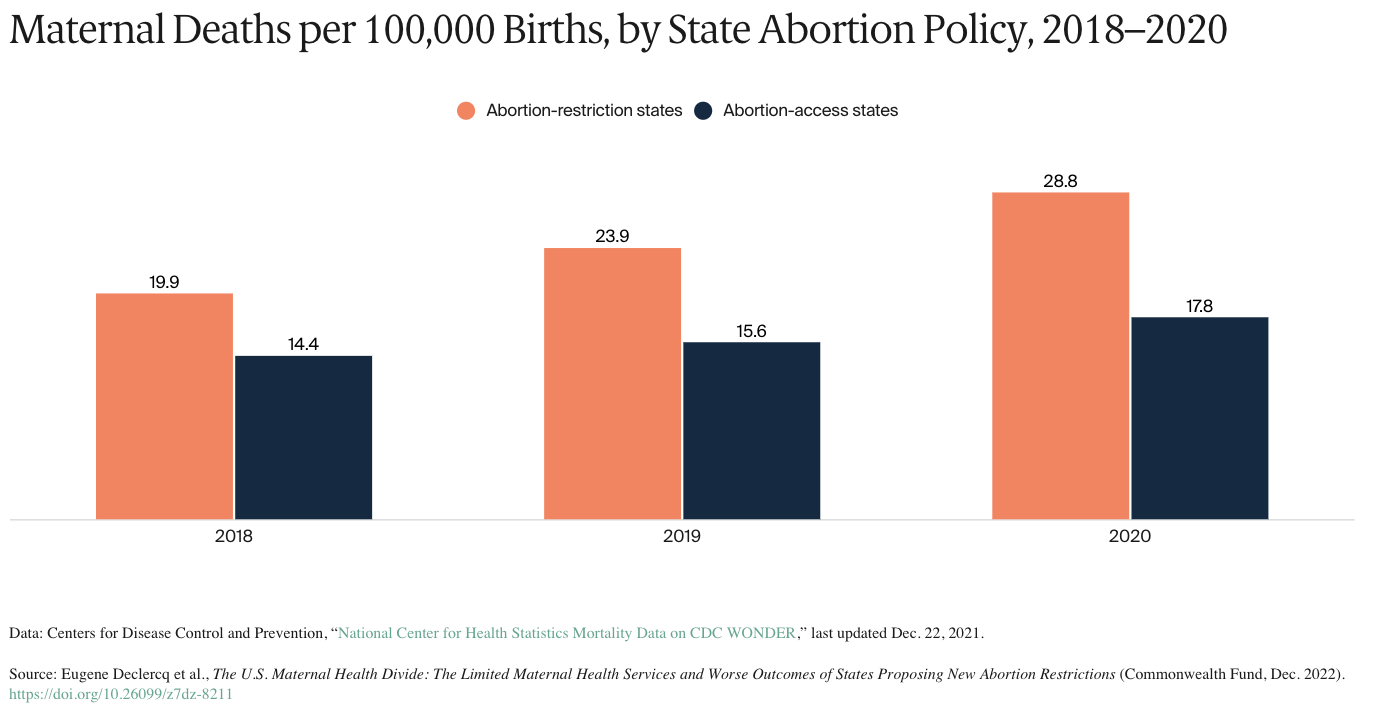It’s been a year since the Dobbs decision overruled Roe v. Wade. How did this impact reproductive health across the nation? Here’s how the scientific story has unfolded, thus far.
State of affairs
Not to anyone’s surprise, a number of states quickly banned or heavily restricted abortions. This means, today, 1 in 4 women of reproductive age live where an abortion is banned or heavily restricted.

This drastic shift has caused a few things to happen.
Internet searches for reproductive care increased
There was an incredible jump in internet searches for reproductive care. This was particularly pronounced in states that had trigger laws. While internet searches came down again, they remained higher than before.

Change in number of abortions is… unclear
There have been 25,640 fewer legal abortions after Roe fell compared to before.
But it’s not clear whether the laws have actually reduced the number of abortions on a national level. Did these people remain pregnant or did they obtain an abortion outside the legal system?
We don’t know.
A clear shift in where people get abortion care
Many people traveled to states where they could get care.
There were 93,575 fewer legal abortions in states that banned or severely restricted abortion.
But a increase of 69,285 legal abortions in states where abortion remained legal.
Travel time increased. A study assessed exactly how much:
Travel times to abortion facilities increased by 3 times.
The largest increases were in the South. In Texas, for example, the new travel time to the nearest abortion facility increased by almost a full workday.
American Indian or Alaska Native, Black, and Hispanic populations experienced large absolute increases in travel time to abortion facilities.
Requests for medication abortion increased. Clinical abortion is not the only option for women. There is a very safe and effective alternative that people can access online and take at home—medication abortion. A JAMA Network study found:
More than 42,000 requests for abortion medications across 30 states.
Requests in every state, regardless of policy, increased after the leak and the formal announcement.
States with total bans had the highest increase in requests. Louisiana had the most medication requests followed by Mississippi and Arkansas.
Negative impact on physicians and care
The Dobbs decision directly impacted physicians in three ways:
A pronounced decrease in the public’s expression of trust in clinicians and health information, overall.
Decrease in residency applications in states with complete bans. Recent medical school graduates were particularly avoidant of OB-GYN residencies.

Most OB-GYNs (68%) reported the ruling worsened their ability to manage pregnancy-related emergencies by removing decision-making autonomy and their ability to practice within standard levels of care.
Are you a physician? Colleagues at UCSF want to hear from you about Post-Roe care. Go to this link for more information.
Increase in maternal mortality is likely
How many women have died because of this decision? This hasn’t been directly measured, but there have been three separate analyses dancing around the subject:
Most OB-GYNs report that the Dobbs decision worsened pregnancy-related mortality.
A recent publication found that in states that restricted abortions from 1974-2016, suicide rates were 6% higher for women of reproductive age. (Note this study used data before Dobbs, but it gives a peek at what we may be facing today.)
A Commonwealth Fund report found pre-Dobbs maternal death rates, overall, were 62% higher in abortion-restriction states compared to abortion-access states (28.8 vs. 17.8 per 100,000 births). (Note this was also before Dobbs.)
There are … silver linings
I don’t know what to call these, but there is some good news:
More public support for abortions than ever before.
2. Media is highlighting abortions more. Abortion Onscreen found more abortion plotlines on TV than any previous year, which will help normalize abortion care.
TV highlighted barriers to access more than previous years, which is helpful in more accurately depicting the situation.
However, 80% of characters were white and portrayed as middle class (45%) or wealthy (35%), which does not represent reality.
Bottom line
Scientific evidence from Year 1 shows Dobbs significantly changed abortion care in the U.S.: where to go and how to get it. Tens of thousands of women’s lives were impacted. Unfortunately, this is just the beginning of the story; we’ll see how it continues to unfold in Year 2.
Love, YLE
“Your Local Epidemiologist (YLE)” is written by Dr. Katelyn Jetelina, MPH PhD—an epidemiologist, wife, and mom of two little girls. During the day she is a senior scientific consultant to a number of organizations. At night she writes this newsletter. Her main goal is to “translate” the ever-evolving public health world so that people will be well equipped to make evidence-based decisions. This newsletter is free thanks to the generous support of fellow YLE community members. To support this effort, subscribe below:








What I’m NOT seeing in the aftermath of Dobbs is an increasing emphasis on pregnancy PREVENTION - which is still almost solely women’s burden. It is long past time for a shift to equalizing that burden, especially now that, with abortion off the table, many tens of thousands of men will now find themselves to be unwitting and unwilling fathers of living children that they will now have the burden to support and provide for. It is time - long past time - for men to be organizing and agitating for safe, effective, reliable measures that prevent them from unwillingly and unwittingly becoming lifelong parents. The male reproductive and hormonal system is so much less complex than that of women. Birth control for men that blocks the production of sperm should be a research priority - and millions of men should be in the streets agitating for it - for themselves, for their wives, for their sisters, for their daughters, for their sons and brothers.
And for those who will inevitably respond that “men can’t be trusted to protect themselves and their sexual partners, or to tell the truth about it, ” I say, “Honey, what’re you doing sleeping with someone you can’t trust??”
there has also been a movement of established, board certified, OB-GYNs out of states with restrictive abortion laws into states without such laws. this has exacerbated already poor access to obstetric care - not to mention women's health care in general - in states such as Idaho, where I live, in which there have been high profile, well-publicized instances of established OB-GYNs moving out of state as a direct result of restrictive abortion laws. not surprisingly, this has also made it exceptionally difficult to recruit new OB-GYN physicians to the state. it would be interesting to see this quantified nationally.
this has obvious adverse implications to women's health. i realize abortion is a challenging and nuanced issue, but once again the bottom line hypocrisy of right wing politicians and judges who purport to be pro-life is on display by the extreme laws they enact and the decisions they make, of which Dobbs is only one example. and, as others have pointed out, this disproportionately harms women who are not affluent enough to travel out of state for care.
surely there must be a more humane way to approach this issue than the system we have now.